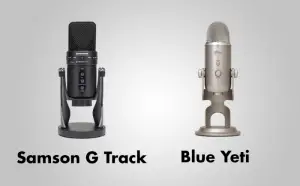
If you’re on the market for a quality microphone, you’re bound to find so many different models that your head is going to spin.
There are just so many brands, and most of them are pretty good actually, which means that selecting a model and declaring it ‘the best’ is no small feat.
Currently, Samson’s G Track and Blue Yeti are gaining in popularity fast, so we’ve decided to check them out and compare them. Let’s get straight to it.
Round 1 – build and design
Both of these microphones are surprisingly sturdy, but even at first glance, you can tell that there are many differences between them.
Firstly, the G Track is both a microphone and a USB interface, which means that you can mix while you’re recording sound at the same time. It’s built from die-cast zinc material and packs heavy-gauge mesh grille. It also features a dual-back condenser capsule and onboard controls. On the flip side, it’s quite heavy for a microphone, weighing some 3.5 pounds.
Blue Yeti is way more straightforward. It packs a tri-capsule array, which means that there are four recording patterns in total you can utilize, including the cardioids, omnidirectional, bi-directional, and stereo. It’s made from rugged plastic materials and is slightly lighter than the G Track, but it still weighs much – it’s 2.2 pounds heavy.
In terms of design, this is an even matchup. Both microphones are very durable and both are quite heavy. If you’re relying on the microphone weight (musicians, interviewers, journalists, etc), the Yeti is a bit easier to use without a mic stand.
Round 2 – intended use
Basically, both of these microphones are enormous in terms of versatility. They can be used for a variety of things, ranging from plain self-recording, over interviews, conference calls and business meetings.
The Samson G Track’s versatility stems from its onboard mixing controls. It packs separate buttons for the microphone and the instruments, but it also features a mute and overall volume control buttons. This makes it perfect for a variety of uses, including conference calls, outdoor interviews, gaming, and such.
It’s also incredible as a studio microphone, again, since it features onboard mixing controls, especially since its frequency response is totally flat.
The Blue Yeti is a bit more versatile. You can use the cardioids mode to capture yourself and anything in your vicinity – this mode is perfect for gaming, podcasting, Skype calls, and such. The omnidirectional mode is perfect for conference calls, as it captures the entire area around the microphone.
The Bi-directional mode is perfect for interviews, as it captures the front and rear. Stereo mode basically works in the same fashion as the omnidirectional mode, with the only difference being in the slightly enhanced focus in this case. This round goes to the Blue Yeti.
Round 3 – price
Even though the price is usually very important for most people, that’s not the case in the Samson G Track and Blue Yeti versus match. Basically, they’re both expensive microphone models that belong in the same price point category.
Though both of them are pricey, the Blue Yeti is slightly less expensive. However, in terms of value, these microphones are evenly matched as they perform absolutely great for the money. It’s up to you to decide which features and in which setting you want to use the microphone of your choosing.
Samson G Track Pros & Cons
There are so many things you are going to love about the G Track that it’s hard to put them all down to paper.
This microphone was built to last, it’s surprisingly easy to use despite the plethora of features it comes supplied with, and it’s as versatile as can be. However, there are a few potential downsides you should be aware of. Let’s see the good and the bad about Samson’s G Track microphone.
| Samson G Track |
|---|
PROS:
|
CONS:
|
| Check prices |
Blue Yeti Pros & Cons
Blue Yeti is an amazing all-around mic that pretty much everyone who needs one is going to adore. It brings so many benefits to the table, including versatility, well-balanced performance, durability, and, of course, a huge value for the buck despite the fact that it’s expensive.
| Blue Yeti |
|---|
PROS:
|
CONS:
|
| Check prices |
Final Verdict
All things considered, we can now safely conclude that both Samson’s G Track and Blue Yeti are exceptional, exquisite microphones. Deciding which one is better was incredibly hard, mainly because they’re so close on all performance levels. In order to better explain our choice, let’s break it down.
Samson’s G-Track features onboard controls and is perfect for live mixing, but Blue Yeti is slightly more versatile due to several operating modes. The Yeti is slightly less expensive, but the G Track is more durable.
Overall, if you don’t need an audio interface and if you don’t mind investing extra attention during the maintenance process, Blue Yeti is a better microphone. It costs less, it’s more versatile, and its frequency response and sensitivity are just as great.
Disclosure: This post contains affiliate links. As an Amazon Associate, I earn from qualifying purchases. This means that if you make a purchase through one of these links, I may earn a small commission at no additional cost to you. Thank you for your support!

